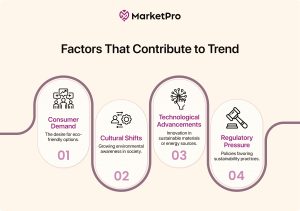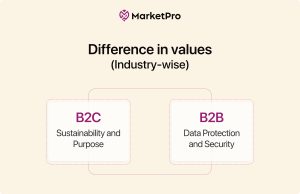Are today’s trends really practicing something new or just a glorified version of past branding trends?
Sometimes, it’s hard to believe that past trends didn’t follow a customer-centric approach or didn’t have a personalization touch in their campaigns. So, how did they actually make a positive impact without all that?
The rise of AI, VR, and AR was not initially driven by consumer demand; they were introduced as innovative solutions to reshape customer experiences. Over time, they evolved into trends and became essential for brands to stand out among competitors.
If you look closely, today’s trends mostly follow the basic principles of past b2b branding: “Show the vision, and back it up with strong transparency.”
However, some trends do take birth and come along with changing cultural and consumer shifts.
Let’s find out who they are, how they exist, and how they differ in various industries.
Changing Branding Trends- From Past To Present
Some branding trends have taken a shift with the passing years. There is no doubt that past branding trends have less personalization touch and focused more on community building.
Still, they were thriving in their domain. However, some of the past trends have proven insufficient in today’s marketplace. And that’s why new trends like transparency, sustainability, and purpose-led branding come into place.
Below is the chart list highlighting the evolution of trends across different categories.

The Evolution of Today’s Emerging Branding Trends…
Apart from trends that still follow traditional principles like influencer marketing, storytelling, and others. Today’s brands are finding ways to get closer to customer sentiments and take branding approaches to the next level. Some of the today’s emerging brand trends are:
Sustainability-Driven Branding: Practicing Beyond Preaching
In today’s branding, sustainability is the major driving factor that emphasizes customer trust and unique perception. B2C companies are more focused on practicing sustainability because of the nature of their products and their connection with environmental factors.
Did you know 62% of Gen Z shoppers prefer to buy from brands that value sustainability?
With the rise of Gen Z and younger generations, brands commit to sustainability to influence their purchasing decisions. Today, the younger generation is hardly moved by “greenwashing” tactics; smacking green labels on products is not enough. The trick is to practice sustainable product packaging, add value to the community, and participate in social and environmental causes. This approach also helps brands with brand reputation management and maintaining a positive image.
Ikea is a solid example in this case. Ikea has made significant efforts to promote sustainability. They made environmentally friendly products that conserve energy and water. 91% of their waste is recycled and incinerated into energy.

Purpose-Driven Branding: Standing For a Cause
Nowadays, consumers are more attracted to brands that stand for something important beyond profits. Purpose-driven branding means integrating morals, mission, and beliefs into business, which is reflected in every aspect of its identity, branding, and marketing. It stated that 75% of consumers say inclusion and diversity influence their purchase decisions.
Modern consumers and the younger generation demand purpose-driven brands that are loyal to their mission and demonstrate through every aspect of their company. They are conscious enough to call out brands that only do these practices to please their customers instead of adding their part to the real issues.
Patagonia is the epitome of purpose-driven marketing. Some of their powerful purpose-driven initiatives are “Patagonia is in business to save our home planet.” Another initiative is “1% for the planet”. Since 1985, they have donated one percent of their sales in pursuit of protecting and restoring the natural environment.
Does this make them a purpose-driven brand? Absolutely! A brand that doesn’t stand for making headlines but sincerely forges to add value to the cause.
How is “Value” Perceived Across Industries in Branding?
Value-focused branding is another trend that boosts brand marketing efforts. It’s not a new trend, mainly looking at past brand strategies and tactics. Value always has to be there, and it’s absolutely non-negotiable, but some brands still fail to articulate that clearly in their branding and messaging.
Suggested Read: Data Driven B2B Marketing Evolving from Ineffective Blind Strategies

Value as a Subjective Concept
Value is a subjective term that varies with each industry’s marketing demands and needs. What is considered valuable in one sector may be completely different in another.
For instance, in B2C industries, the key value propositions are sustainability and a strong purpose, which businesses powerfully demonstrate in their branding campaigns.
In B2B sectors, data protection, security, and transparency are often defined as value propositions, and these terms set the foundation of their branding trends.
TOMS (B2C Example) – A famous shoe company introduced the “One for One” model, where each shoe purchase was followed by donating a pair of shoes to persons in need. This purpose-driven approach highlights their part in creating social impact.
Salesforce (B2B Example) – A CRM company that demonstrates trust, data security, and transparency. It showcases a solid commitment to protecting customers’ sensitive information and ensures data protection.
Debunking Branding Misconceptions
Let’s discuss some of the common misconceptions around B2C and B2B branding trends.
Perception around AI, AR, and VR as Trends
AI, VR, and AR are part of experiential marketing and have been introduced as technological solutions to improve customer experiences and operations.
There is a common misconception that this technology’s existence is driven solely by customer demands. In fact, it is a technology that was aimed to disrupt industries and customer experiences.
Yes, they are the most in-demand branding trends today and are adopted by many brands to stay competitive. However, their genesis was more technological-driven.
Chasing Every Trend Blindly
There is a misconception that brands must follow every trend to stay relevant.
While keeping up with the world is essential, blindly following every trend still sometimes backfires in branding. Not knowing your brand vision and target audience leads to dilution in messages and confusion among consumers.
Influencer Marketing as a New Branding Trend
Where influencer marketing plays a crucial role in social media branding today, this concept is not relatively new at all. The idea of using influencer individuals to promote products and services has been going on for a long time.
Celebrities, actors, and influencer makers have been endorsing brands for decades. The only difference is the medium of platforms- today, it is more digital.
Wrapping Up: What The Future Holds For Branding
Now, we have a clear view of branding trends and how branding practices have changed in the past years. Even though AI, VR, and AR technologies were introduced by companies to influence customer experience, falling under experiential marketing. They are now one of the most crucial branding trends and will reach even more profound heights in the future. Metaverse is already proof of this. The principles will stay the same, but new trends like sustainability, purpose-driven marketing, and many others will exist in the future.
At Market Pro, we elevate brands with a clear purpose and mission. With a knack for data-driven branding, we can help your business stand out in today’s competitive marketplace.

